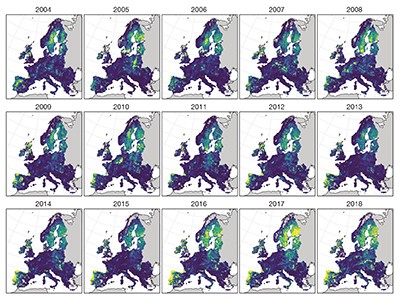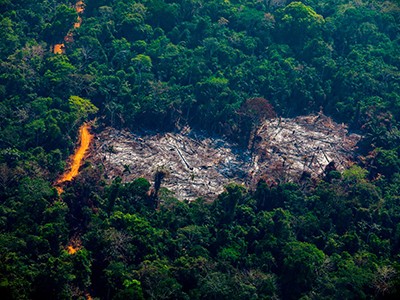
It can take years for small, young trees (such as this one in Gran Canaria, Spain) to absorb the amount of carbon that is released when old-growth forests are lost.Credit: Desiree Martin/AFP/Getty
A study published this week reveals how European countries’ need for wood biomass is contributing to an increase in forest harvesting1. The finding comes from a team of researchers at the European Commission’s Joint Research Centre in Ispra, Italy, whose conclusions are based on satellite data.
Between the period of 2011–15 and that of 2016–18, ‘harvested’ forest area — defined as the part of a forest where trees are cut down and others planted in their place — increased by nearly 50%, from 0.76 million hectares to 1.13 million hectares. Of the 26 member states assessed, just 2 — Finland and Sweden — accounted for half of the increase.
Read the paper: Abrupt increase in harvested forest area over Europe after 2015
This is an important finding. It has implications for biodiversity and climate-change policies, and for the part forests play in nations’ efforts to reach net-zero emissions. Forests account for about 38% of the European Union’s total land surface, and offset about 10% of its total greenhouse-gas emissions by acting as carbon sinks.
The surge in harvesting might reduce forests’ ability to absorb carbon from the atmosphere, the authors say. One reason for this is that large amounts of carbon are released quickly as older trees are felled — but it takes much longer for the same amount of atmospheric carbon to be absorbed by the smaller, younger trees planted in their place.
Paradoxically, the increase in harvested forest area has been driven, in part, by demand for greener fuels, some of which are produced from wood biomass. That includesbioenergy, which comprises about 60% of the EU’s renewable energy. This increase in biomass products can, in turn, be traced to the EU’s bioeconomy strategy, a policy that has promoted the use of forest resources for energy, as raw materials for industries and to create jobs.
The bioeconomy strategy has been a success in one respect: total economic output from the EU’s forests between 2012 and 2016 rose by 25%, from €43 billion to €54 billion— and the increase doubled to 50% in Poland and Sweden. But economic success has come at an ecological cost.
When will the Amazon hit a tipping point?
Many of the continent’s leaders are advocates of a set of ideas known as the European Green Deal, which aims to keep economies growing and create jobs by promoting greener development. However, these objectives can end up counteracting each other. For example, in its new biodiversity strategy, published in May, the EU proposes planting 3 billion trees. But it also suggests designating 30% of land (up from 26%), including old-growth forests, as protected by 2030. If forest harvesting continues at the current rate, such an ambition will be difficult to achieve.
The EU also has a target to double its share of low-carbon and renewable energy to 34% from 2015 to 2030. The European Parliament agreed that the burning of wood could count towards this target. But if wood were to supply even 40% of the extra energy, that would mean burning all of Europe’s existing harvest, profoundly threatening the world’s forests.
The European Commission is designing a new forestry strategy, expected in 2021, that will complement the biodiversity policy. The Joint Research Centre has been asked by the commission to establish a permanent EU observatory on forests. This will draw on the type of satellite data used in the current study to more regularly monitor deforestation, forest degradation and changes to global forest cover — and will make the data accessible to the public. The researchers drew on data from the joint NASA/US Geological Survey Landsat series of Earth-observation satellites and the Global Forest Change data set, and used Google Earth Engine, a facility that enables researchers to use Google’s supercomputers to process satellite imagery.
The planned forest observatory is a crucial development, and one for which the commission deserves to be commended. Once its data become available, EU member states need to incorporate them into the official statistics that policymakers use to make decisions — for example, when planning strategies to reach net-zero emissions. Many countries’ forest data — including those that are reported to the EU’s statistics office, Eurostat — are based on manual forest surveys. Such surveys are important, but in some cases they are carried out only at decadal intervals, partly because they are expensive. A dedicated observatory will provide decision-makers with much more timely data and help them to identify unintended consequences of their policies.
Ultimately, data must drive action. And, as we have often written, time is running out. Forests provide valuable services on which people and the environment depend. Their exploitation cannot continue at the current rate.

 Read the paper: Abrupt increase in harvested forest area over Europe after 2015
Read the paper: Abrupt increase in harvested forest area over Europe after 2015
 When will the Amazon hit a tipping point?
When will the Amazon hit a tipping point?
 Adopt a carbon tax to protect tropical forests
Adopt a carbon tax to protect tropical forests
 Restoring natural forests is the best way to remove atmospheric carbon
Restoring natural forests is the best way to remove atmospheric carbon




